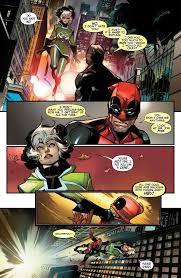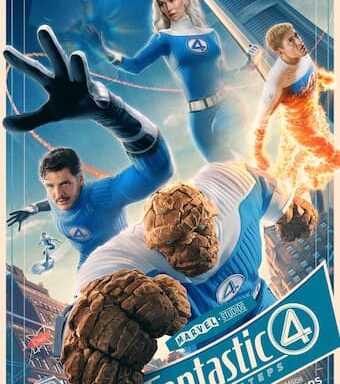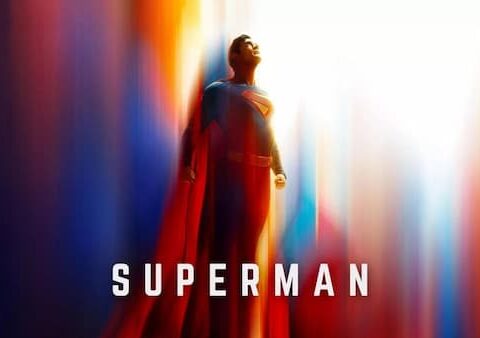So, picking up from the review of the previous sequence of Uncanny Avengers issues here.
Uncanny Avengers #13 puts us firmly in Civil War II territory. As crossover issues go, this one is actually very good: playing in to the Civil War II storyline in clever and meaningful ways and not just throwing out a barely-linked story just to bear the Civil War II banner on it.
In particular, the main story of Deadpool’s mission to break Hawkeye out of prison is very nicely done. Particularly clever is the way it starts – by showing us a strictly Deadpool’s-eye perspective of an event we’ve already seen in the pages of the main Civil War II title.
Specifically, we see the scene of Barton’s attack on Bruce Banner again, only this time purely from Deadpool’s perspective, including his own inner monologue.
It’s a very smart way of doing this and it genuinely did make me go back to the original sequence in the Civil War II title to re-read it and then match it up to this Wade-centric version. It holds up very nicely.
The subsequent material with Wade’s aborted jail-break attempt is also solid; nicely told, both visually and in terms of Wade’s thought processes, and also in terms of the Barton/Wade interaction. The other part of the book, specifically dealing with Captain America’s conflict of interests with Cable, is more set-up than story, but it provides good intrigue, particularly when it is revealed that Rogue is working with Cable too.
Uncanny Avengers #14 continues along these lines and is aided by generally strong character details (aided as ever by Deadpool’s witty interjections): beginning with Bruce Banner’s funeral and going on to the Cable/Rogue-centered action.
What this issue also showcases is this title’s ability to seamlessly juggle multiple plotlines and character pieces: Uncanny Avengers #14 handles the Civil War II element, does further set-up for the Inhumans/X-Men storyline, does a brief Quicksilver plot positioning and then also deals with Voodoo and bringing in a new story involving The Hand.
But it does all of this deftly, which isn’t necessarily easy within the relatively small space of a standard-length comic book.
The main focus of #14 is the fall-out between Rogers and the Unity Squad’s Mutants, who’ve been going behind his back to steal US military research on the Terrigen problem. This stuff is all done very well; everyone’s actions, though in conflict with each other, make sense. Everyone’s emotional response fits too: Rogers’ sense of betrayal, Rogue’s unhappiness, etc.
It was really nice here too that we got into Rogue’s mind and her perspective on these events too, instead of just centering on Rogers or Cable.
While Rogers and Cable part ways, an enraged Rogers fires Deadpool and disbands the Unity Squad. A shocked Rogue accepts her own dismissal, but vouches for Deadpool and urges Rogers to keep him on – which is also a nice character moment.
This is all well written stuff, with genuine tension and with strong character work that makes the most of this title’s excellent dynamics. Importantly – and this is something that writers miss too often – all of the characters’ actions ring true and make good sense.
Of course, when it concerns Steve Rogers, everything he does and says has to also be interpreted in the context of the broader, Nick Spencer arc going on right now – which makes all of this stuff even more interesting.
However, for the purposes of these reviews, I elect to refrain from taking this on to too many levels.
That being said, one of the great things about what is going on elsewhere with Captain America right now is that you end up wanting to re-read a number of other books in the context of Rogers’ hidden motivations. That works here in Uncanny Avengers, for example, and also applies to the entire Civil War II series, where you’re inclined to a do a ‘straight’ reading of the story first, but then – later on – to do an additional reading where you’re really just studying what Rogers is doing.

That additional dynamic imparts extra shelf-life to some books that might otherwise be put away fairly quickly.
On a minor note, I also like seeing Toad brought into the action – a character I have a soft spot for, but who is generally neglected these days. Uncanny Avengers #14 is a particularly strong installment – a highlight, even amid a series that has generally maintained a high standard of quality.
Uncanny Avengers #15 (presented as ‘Civil War II: The Aftermath’) features a striking, ominous cover of Rogers, with his back to us, looking a little sinister.
While this issue centers on Voodoo leading the ‘team’ on a mission to Japan to rescue Bruce Banner’s body from The Hand, the opening Rogue/Deadpool sequence is the best thing in this issue – and it reinforces why Rogue and Deadpool are probably the main reason this series is currently so readable and dynamic.
It’s a simple scene, really – just the two of them looking a little lost and listless, wondering what to do now that Cap has disbanded the Unity Squad. But it’s funny, it is perfectly attuned to their characters, and it’s just a really good, character-centered way to open a story.
The dynamics of a disbanded Unity Squad going on a mission are also interesting. Rogue is all business – as soon Voodoo tells her they need to rescue Banner’s body, she’s all about going on the mission immediately. She doesn’t even tell Quicksilver, Torch or the others that the squad has been disbanded by Captain America – they just go straight to Japan to do what needs to be done. There’s something very pleasing about that; and it’s kind of what you’d want these characters to do – to not get bogged down in politics, rules or ‘sides’, and to simply go and do whatever urgent thing needs their attention.
Wade calling in Elektra gives us a pretty gimmicky cameo, but it’s a fun anyway to have her in on the action. Everything else is just honest, wholesome comic-book fun as the extended gang (including Wasp, which is also pleasing) fight their way to retrieving Banner’s body – although, of course, they end up with something other than what they bargained for.
The action pours in to Uncanny Avengers #16, with the gang trying to contain a giant, zombified/resurrected super-Hulk in Japan.
Here, I have to register a slight qualm I have with this whole diversion: it seems to me like a distasteful treatment (by the writer) of Bruce Banner to have his deceased body re-animated and going on the rampage like a Godzilla. Really, Banner has only just died (in the pages of Civil War II), and this feels like an untactful story that really both disrespects the character and trivialises death itself.
I disapprove of the idea on that basis.
All of that being said, I actually really enjoy this action – not because of, but in spite of, the Hulk/Banner. And it’s because the characters are so enjoyably written, the dynamics are so good, and the characters play off each other so well in this series.
Having Wasp around and adding Elektra (and later, Toad and Shaw) into the mix also adds even more to this. Just having this grouping of characters on a mission together is fun, and with the solid art and easy-flowing dialogue, it’s never not enjoyable to read.
Again, I just object to this whole thing of Banner being resurrected as a zombie-Godzilla: having this same grouping of characters go off on some other, non-Banner-related mission would’ve been just as fun. As it is, this whole diversion seems tactless. I mean, in #17, not only is everyone basically beating the crap out of the resurrected Hulk, but Elektra even make a quip at his expense after stabbing him in the eye. Seriously.
Again, the action and the inter-character dynamics are generally wonderful, regardless of the questionable nature of this particular story. And, admittedly, Doctor Voodoo communing with Banner’s spirit and bringing him peace (literally, letting him ‘into the light’) is a reasonably poignant ending. However, when Voodoo tells the departing spirit of Banner, “I’m sorry they abused you”, he may as well be talking about the writers.
He’s actually talking about The Hand; but the sentiment applies to both.
The Rogue epilogue helps remove some of the bitter taste. Centering on Rogue is always good, and her inner monologue here about loss and sacrifice is fairly poignant, particularly her line that “we save the world, but never each other”.
I’m watching and waiting perpetually for a Rogue solo title – it is long overdue. In the meantime, however, she continues to shine brightly in these Uncanny Avengers pages, just as she has done in every iteration of the Uncanny Avengers title to do date.
We’re reminded here too that the Red Skull, via the telepathic powers of Professor X, has taken psychic control of Quicksilver. Uncanny Avengers #18 and #19 put Schmidt’s diabolical plan into operation, with Pietro as his unwitting servant of darkness.
As much as the Red Skull sometimes come across as a villain of the silly type, he also still has the power to come across as a genuinely creepy, unsettling villain too. It is, in fact, hard to think of a Marvel villain more unequivocally evil than him, and this is part of why he still works so well (mostly) as the scheming monster behind so much of the villainy going on in the MU.
Uncanny Avengers #19 boasts a very good cover that pretty well encapsulates what follows in this installment, with the team all under the telepathic control of the Red Skull. Parts of this are genuinely creepy, as the Skull subjects each of his victims to psychic nightmares. Jan/Wasp’s false vision of an encounter with Hank Pym is unsettling (she is revealed to be an artificial lifeform in this vision).
Johnny Storm’s vision is particularly cruel, as he is first elated to find himself reunited with the Fantastic Four, but his elation turns to nightmare when he accidentally burns them to death. What’s particularly unsettling about Johnny’s vision is that the Fantastic Four we’re shown are depicted as classic, sixties-era FF, so that it is made to play even more to our nostalgia – just as it is for Johnny himself – and is thus even more harrowing when he accidentally immolates them.
There’s an obvious element of Freddy Krueger and Nightmare on Elm Street to all of this; but it is effectively unsettling storytelling. With another villain, it might not be – but with Schmidt, being the evil, creepy Nazi that he is, it definitely makes for genuinely nightmarish reading.

Some of these bits are, as mentioned, genuinely creepy. Such as the absurd image of a giant version of the Red Skull bursting up through the ground to attack Cable: it isn’t ‘real’ of course, but a nightmare being inflicted on Cable via telepathic attack. But it is creepy.
All is not lost, however: Deadpool (who else was it going to be?) manages to escape Quicksilver and get away. And he makes it to Doctor Strange’s place, where Spiderman soon shows up too.
This run of Uncanny Avengers – like the previous runs – continues to thrive on its winning formulas. And #19 is among the better issues.
Uncanny Avengers #20 wastes no time and throws right into Spiderman and Wong (Dr Strange’s assistant) being in battle against the Schmidt-controlled Unity Squad members, with Deadpool attempting to get to the Red Skull’s location and take him on personally.
Some of this veers towards comic book silliness at moments; but generally it all holds up well enough, and injecting Spiderman into the action helps keep it lively.
The real centerpiece of this issue is the brutal confrontation between Deadpool and the Schmidt-controlled Rogue. Rogue is in fact Schmidt’s last line of defense, but she is on hand to save the Skull from Wade. More than that, she proceeds to pummel the crap out of him in a sequence of really superbly illustrated images that depict Wade being battered to a pulp by her.
The visual presentation of this is really top-rate and the fight has an emotional undercurrent to it – at least it did for me anyway, primarily because I really hate seeing Rogue under the control of the Red Skull. I feel violated by it as a reader (and Rogue fan); and, no doubt, she feels incredibly violated by it. This grim battering of Wade by one of his team-mates is accompanied by Schmidt’s gleeful, patronising commentary, as he revels in what he is subjecting all of these characters to.
The discomfort as a reader in seeing Rogue under the control of the Red Skull and battering the crap out of Wade is remedied very quickly in Uncanny Avengers #21: as Deadpool reveals his ace card – Magneto’s helmet, which he manages to place on Rogue’s head. This is an act that changes the dynamics entirely, blocking Xavier’s telepathic brain from being able to maintain any control over her.
On multiple levels, this was a genius bit of writing that made my week.
Firstly, it’s so clever just in strategic terms. Secondly, having Rogue proceed to take down Red Skull is beautiful. But thirdly, this works so nicely in symbolic terms too. This is firstly because having the Nazi Schmidt be undermined by a piece of the Holocaust survivor Magneto has a subtle poetry to it.

It is also because having what’s left of Charles Xavier be rescued in part by the helmet Magneto once designed to shield himself from Charles is rather rich.
And also because seeing Rogue don Magneto’s helmet is a lot of fun, especially given her history with Magneto. My memory and nostalgia is often very selective – in thinking back, I’ll often skip over years and years of material and my mind will go straight back to Claremont’s Mutant Genesis material and some of the classic Rogue/Magneto scenes from there. All of that came quickly to mind when I looked at Rogue donning the helmet.
And more than all of that, having Rogue be the one to – at the end – physically take down and neutralise the Red Skull makes me very happy.
Rogue taking Schmidt to Henry McCoy to remove Xavier’s brain makes perfect sense – the one thing I wish, in Uncanny Avengers #22, is that we could’ve gotten a bit more here with McCoy’s surgery on Schmidt. We might’ve got some good material out of Hank doing the job, with Rogue present.
Nevertheless, there’s plenty here to keep the story going.
If having Rogue take down Red Skull (albeit with massive, intricate, help from her team) was pleasing, having her stand up to Steve Rogers here is just as pleasing. She in fact flat-out defies him in his request to take Xavier’s brain into his custody.
The dynamics are interesting, and it’s frankly nice to see Rogers get shafted and even more nice to see Rogue stand up to him and handle the situation herself.
Meanwhile, Rogue and Deadpool’s mid-air kiss is genuinely a sweet moment and is beautifully visualised. Scenes and moments like this can be badly done; cheesy, annoying or seemingly arbitrary. But this isn’t any of those things. It’s still edgy and true to the two characters, is in-keeping with the flow of the story and the preceding events, and is strikingly rendered and presented to us. Wonder Man’s psychic intrusion into the moment is also a nice turn – which I hadn’t seen coming.

Uncanny Avengers #23 brings us to an ending of sorts; literally called ‘Coda’.
And as wrap-ups go, it’s a pretty nice one. There’s no big plot here, just simple character pieces and low-key dynamics, but it all feels rather cosy and pleasing. The ‘fallout’ (there’s really no fallout) from the Rogue/Wade kiss/union in the previous issue is all low-key and barely registers. What we do get on this front is all cute and perfectly in keeping with how the characters have been written all through the series.
Wonder Man’s ‘return’ is a nice bonus here, and in general this issue is populated with nice, simple character moments and interplay. The closest thing to a serious story here is Synapse going into Cable’s mind to try to restore his consciousness after his ordeal with the Red Skull. This is fairly interesting stuff, but resolves itself quickly and easily (it does give us a Stryfe cameo of sorts – but not really).
This also sheds some more light for us on Synapse’s future and her connection to Cable; which is a good enough place to leave things here.
In the final few strains, we get the gang showing up at Rogue’s place. Even though the mission is over and the team disbanding, it seems there’s one more low-key mission they’re all about to go off on.
The mission isn’t and won’t be shown, of course – but it’s a perfect little note to finish off on.
Uncanny Avengers #23 actually feels like an X-Men comic; particularly, it feels like an old-school X-Men comic, where it all centers on character dynamics and relationships and a montage of quiet moments.
It’s a pleasant, low-key point after what has been an edgy, plot-heavy series. It has also been a thoroughly enjoyable, lovable series all the way, which has kept up the Uncanny Avengers brand’s unbroken run of winning incarnations for several years now.
Notwithstanding what Nick Spencer has been doing on the Captain America: Steve Rogers (reviews here and here) book, this Uncanny Avengers title has possibly been my favorite monthly book for the passed year-plus.





